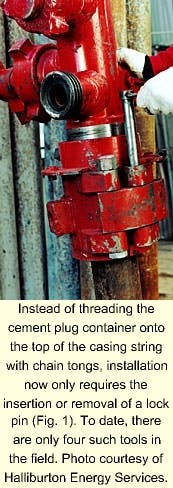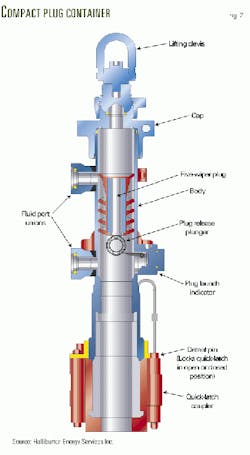A compact plug container, installed with a quick-latch coupler, allows the head to be quickly and easily attached to the casing during cement operations, reducing the risk of injury (Fig. 1).
In the past, a high percentage of failures occurred at the threads where they attach to the casing (Fig. 2).
An integral quick-latch coupler, developed by Halliburton Energy Services Inc., Duncan, Okla., however, eliminates the chance of failure caused by thread shearing. Halliburton tested the tool in fall 1999 and has run 100 jobs since.
Conventionally, plug containers must be threaded on to the box end of the casing string, requiring multiple turns by service employees who often work 10-40 ft above the rig floor with chain tongs and hammers.
Quick-latch
To install a compact plug container with a quick-latch coupler, the operator performs the following steps:
- Place head above the casing with the quick-latch coupler in the open position.
- Pull the pin from the latch.
- Spread the clamp apart.
- Replace the pin in the latch.
- Lower the head onto the casing until the coupling makes contact with the seal in the body of the plug container.
Next, the service hand closes the latch around the casing by pulling the pin from the latch, then closes the clamp and replaces the pin. Finally, he threads the quick-latch coupler onto the head until it contacts the lower face of the coupling, sealing the upper face of the coupling.
To remove the plug container, the operator reverses this procedure. After the plug container is installed, the operator should tie the head to the hook or bails to support its weight, further reducing the risk of injury. In most cases, a chain can be attached to the plug container's lifting device and tied off to the bails. The chain provides a secondary restraint required in most safety plans.




